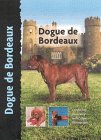
Dogue De Bordeaux
The Dogue de Bordeaux is a powerful, strong-willed dog which has some similarities to the Neopolitan Mastiff. Well-bred individuals are generally calm and well-behaved with people they know, and they can be very good with children who respect them, but young dogs can easily knock over children in play, and have been known to knock over adults. These dogs may also drool all over you. Pups need to be taught not to jump up, and to play gently with people.
The modern version of this breed is generally patient and tolerant with its human family, but the breed was originally designed to be aggressive, and it is important to check the temperament of both parents of any pup you are interested in. The Dogue de Bordeaux is a natural guard dog, which should be socialized extensively as a pup, so that the adult is safe with people. Socialization should continue throughout the dog's life. Teaching your dog to behave well with a range of people will not prevent this breed from carrying out guard duties - it has a naturally strong drive to guard and protect.
This is an intelligent breed, which can learn fast, but can also be headstrong and will pick up on any inconsistencies in how you enforce house rules, so skill is needed in training. The Dogue de Bordeaux does best with an experienced owner who has already worked with large, headstrong breeds, and who is able to be firm, consistent and calm. These dogs do not like being teased, and they have good memories, so children and visitors should be warned. It's safer to keep children and dogs separate if you have a lot of young visitors who don't understand dogs, and might plague your pet.
Socialization with other dogs as a pup may not be enough to prevent aggression against other dogs in an adult Dogue de Bordeaux. This means that they should be walked in public parks with care, and always on a lead. They need a fair amount of space, such as a large garden, since these dogs should be active to stay fit, and can't always be walked easily. They do benefit from frequent walks at a reasonable pace, and need to see the outside world, so that they are not spooked when you have to take them out.
You may need to develop strategies for safe walking, such as going out very early, if your dog takes a dislike to most others he meets, and you live somewhere where there are a lot of other dogs. It's also worth making sure you can see whether another dog is coming, if bumping into another dog as you turn a corner could create problems. Novice owners can benefit from training classes with someone who has experience of mastiff-type dogs, and who enjoys working with them. Obedience training means that you should be able to get your dog to ignore other dogs that don't come foolishly close, even if he is dog aggressive.
Common health problems include hip dysplasia, juvenile lameness, heart trouble, skin disease, hypothyroidism, and bloat. Pups need careful regulation of their food and exercise so that their bones develop properly, as is the case with most big dogs.
This book is a very good introduction to the breed, which gives a lot of helpful information on general care, including health care. It is well illustrated, and should interest experienced and novice owners.



